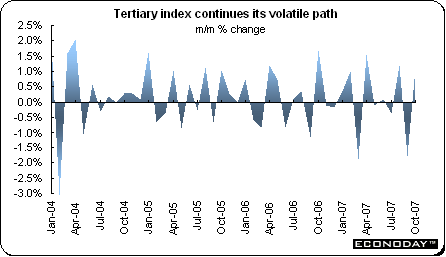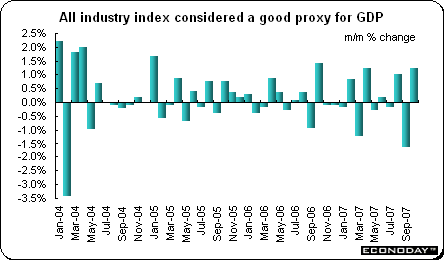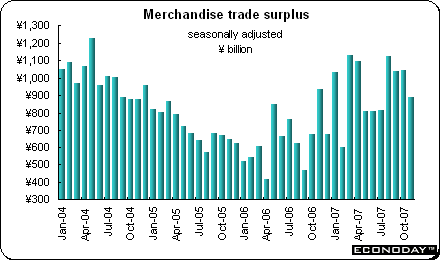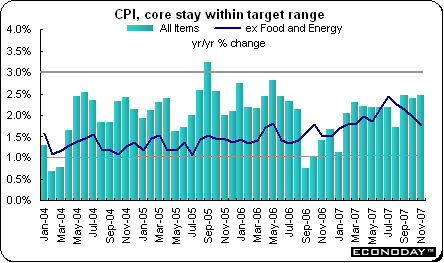|
International Perspective will be taking off next week. IP will return on January 4, 2008.
Happy New Year from all of us at Econoday!
Reverberations from higher than expected U.S. inflation data continued to be felt as the new week began. Stocks tumbled worldwide on Monday on fears that higher inflation would translate to lower U.S. sales for international companies. The mid-week period was indecisive as equities meandered about, mostly to the downside. However on Friday, equities staged a rally that started in Asia and spread to Europe and then North America. Stocks in Europe and North America were bolstered by better than expected U.S. consumer spending data (Asian markets were closed by that time.) All indexes followed here ended the week on a positive note, although for many the gains were insufficient to wipe out earlier losses. Financial markets will be happy to see this year end as banks and other investment institutions continue to purge losses from their balance sheets.
Indexes in Australia, Japan, South Korea, Singapore, France, Canada and Mexico were down on the week.
|
|
2006 |
2007 |
% Change |
|
Index |
Dec 29 |
Dec 14 |
Dec 21 |
Week |
Year |
| Asia |
|
|
|
|
|
|
| Australia |
All Ordinaries |
5644.3 |
6556.1 |
6309.4 |
-3.76% |
11.78% |
| Japan |
Nikkei 225 |
17225.8 |
15514.5 |
15257.0 |
-1.66% |
-11.43% |
|
Topix |
1681.1 |
1501.3 |
1469.2 |
-2.13% |
-12.60% |
| Hong Kong |
Hang Seng |
19964.7 |
27563.6 |
27626.9 |
0.23% |
38.38% |
| S. Korea |
Kospi |
1434.5 |
1895.1 |
1878.3 |
-0.88% |
30.94% |
| Singapore |
STI |
2985.8 |
3466.4 |
3398.1 |
-1.97% |
13.81% |
| Shanghai |
Shanghai Composite |
2675.47 |
5007.91 |
5101.78 |
1.87% |
90.69% |
| Europe |
|
|
|
|
|
|
| UK |
FTSE 100 |
6220.8 |
6397.0 |
6434.1 |
0.58% |
3.43% |
| France |
CAC |
5541.8 |
5605.4 |
5602.8 |
-0.05% |
1.10% |
| Germany |
XETRA DAX |
6596.9 |
7948.4 |
8002.7 |
0.68% |
21.31% |
| North America |
|
|
|
|
|
|
| United States |
Dow |
12463.2 |
13339.9 |
13450.7 |
0.83% |
7.92% |
|
NASDAQ |
2415.3 |
2635.7 |
2692.0 |
2.13% |
11.46% |
|
S&P 500 |
1418.3 |
1468.0 |
1484.5 |
1.12% |
4.66% |
| Canada |
S&P/TSX Comp. |
12908.4 |
13674.2 |
13596.1 |
-0.57% |
5.33% |
| Mexico |
Bolsa |
26448.3 |
29994.9 |
29638.4 |
-1.19% |
12.06% |
| Markets in South Korea were closed on Wednesday, December 19 |
|
|
| Markets in Singapore were closed on Thursday, December 20 |
|
|
The FTSE and DAX managed to salvage a victory from the jaws of defeat on Friday as a rally sent the two indexes into positive territory for the week. After sinking on Monday as did most major world indexes, the FTSE struggled to regain those losses, which it was finally able to do Friday. The CAC and DAX had a more mixed week after Monday’s decline, but while the DAX managed to end the last full trading week of the year on a positive note, the CAC edged down slightly. On Friday, positive November U.S. consumer spending data showed that the U.S. consumer is alive and well and gave a positive boost to equities. Mining companies and automakers along with some technology stocks were European favorites on Friday while in the UK, financial stocks, the source of investors’ woes for the past several months, sparked the increase. Thursday’s positive close in U.S. trading also helped as did exuberant Asian trading overnight. On the week, the FTSE was up 0.6 percent and the DAX was up 0.7 percent — but the CAC edged down barely 0.1 percent. All three indexes are in line to finish their fifth successive positive year.

After sinking on Monday, stocks in the Asia/Pacific region meandered midweek, but finished on Friday with sizable gains. The Hang Seng and Shanghai indexes managed to recoup the losses incurred earlier in the week but the others followed here were not as fortunate. Persistent concerns that the credit crisis (and subprime woes) will threaten worldwide economic growth spooked investors. Analysts reached back to the late 70s when they expressed their concerns that stagflation would rear its head given rising U.S. prices (thanks to rising energy prices) and expected slow growth. Investors fretted that higher inflation would reduce consumer spending and therefore exports from Asian countries. They were also concerned that higher inflation would limit the Federal Reserve’s ability to cut interest rates to stimulate growth. Only the Nikkei and Topix are down for the year 2007.

Bank of Japan interest rate unchanged
As universally expected, the Bank of Japan left its key interest rate at 0.5 percent after a drop in business confidence signaled companies are bracing for slower economic growth. The vote was unanimous. The BoJ interest rate has been at this level since February 2007. Costlier oil and raw materials have been eating into corporate earnings and slower U.S. growth threatens demand for Japanese exports. Bank governor Toshihiko Fukui has said that weak profits at small companies could hamper wage growth and consumer spending. He also acknowledged that the benefits of the corporate-led expansion have not flowed to households as quickly as he had anticipated. Even though corporate Japan has returned to profitability, wage growth remains sluggish, making workers reluctant to spend. In the recently released Tankan Survey, large manufacturers and service companies were the least optimistic about the economic outlook in more than two years.

The Japanese government Cabinet Office slashed its growth estimates for the economy. It now expects it to grow 1.3 percent in the fiscal year to March 2008, down from earlier forecasts of 2.1 percent. The downward revision partly reflects more stringent standards for house builders. New rules have extended the approval process, with insufficient staff adding to the bottlenecks. The Cabinet Office also forecast that the economy would grow 2 percent in 2008-09 fiscal year, and that the country would pull out of deflation next year, with the GDP deflator rising for the first time in 11 years from next April.
The Bank of Japan monetary policy board also cut its overall economic assessment for the first time in about three years. In their latest report they noted a moderate expansion in the economy but said “the pace of growth seems to be slowing mainly due to the drop in housing investment.” By saying so, the policy board kept the general view that the economy continues to show gradual growth but that the pace of growth is likely to slow for the time being. And at his press conference following the MPB meeting, governor Fukui cited uncertainty in the global economy and international financial markets as well as a slowdown in the domestic economy. Specifically, he cited a sharp decline in housing starts due to the revised construction standards law as a major reason behind the slowdown in Japan. He said that rising basic materials prices are putting pressure on the earnings of small and midsize companies, leading some of these firms to hold down payroll costs.
The People’s Bank of China announced an increase its key lending interest rate for the sixth time this year by 18 basis points to 7.47 percent on December 20 (the new rates were effective on December 21). At the same time, it also increased its one year benchmark deposit rate by 27 basis points to 4.14 percent. The move is intended in large part to ease growing public concerns about rising inflation. The announcement of the rate increase came shortly after the People's Bank of China released a survey of depositors showing their dissatisfaction with price levels and expectations of continued increases which are both at recent highs. The November consumer price index was up 6.9 percent on the year thanks in part to soaring prices for pork. Rising inflation comes at a time where there are broader concerns about the Chinese economy amid signs of over-investment in some sectors and forecasts of a downturn in demand from the U.S.

In its post quarterly meeting statement, the Bank reiterated the central government's position on resurgent inflationary pressure and its strategy to tackle it. The PBOC said that it would tighten monetary policy, warning that the pressure on domestic price levels to rise is increasing. The PBOC also said it would use interest rates to guide the public's inflationary expectations. That marked the first explicit reference to the use of interest rates in guiding public inflationary expectations, where in previous statements the bank would only talk of the use of “price tools”.
The U.S. dollar continued its rally against the euro, yen and pound sterling last week. Against the U.S. dollar, the yen has been trending down in value since hitting a high of ¥108 the end of November. The yen dropped against the 16 most actively traded currencies on reduced concern that credit losses will weaken global economic growth. This encouraged some investors to resume borrowing in Japan to buy high-yielding assets elsewhere. The yen was down Friday after U.S. consumer spending rose last month by the most in more than two years and the cost of borrowing dollars and euros declined. The Federal Reserve said on Friday that it will conduct emergency auctions of loans as “long as necessary” to restore faith in the money markets.

The euro has been trending down against the dollar since December 12 when it hit a recent high of $1.47. The euro lost ground after the Ifo index of German business confidence dropped to its lowest level in almost two years — even though analysts said that although the drop in the Ifo suggested slower growth in the eurozone next year, the index remained well above its long-term average. Most analysts expect the European Central Bank to keep its key interest rate at 4 percent in the first quarter of 2008 because of inflationary concerns.

The pound sterling dropped below $2 on December 19 to close below that level for first time since doing so briefly on September 19. It did so after the Bank of England’s December meeting minutes revealed that all nine members of the monetary policy committee voted to lower interest rates by 25 basis points to 5.5 percent. Analysts said the unanimous decision and the general tone of the minutes indicated that another interest rate cut early in 2008 was likely. Sterling’s woes were compounded later in the session as a downbeat survey from the Confederation of British Industry supported anecdotal evidence that the UK retail sector was set for a tough Christmas period. The pound dropped to a record low against the euro Friday as the prospects of a near-term cut in UK interest rates continued to weigh on the currency. The pound dropped to a low of £0.7256 against the euro, its weakest level since the launch of the single currency in 1999. And this was despite retail sales figures which came in slightly better than expected in November.

Continuing higher than expected price data continued to be the theme of last week’s indicators, especially in Germany and France where evidence of spiking commodity prices showed their impact. But the UK was the exception where the consumer price increase was close to the Bank of England’s inflation target. Retail sales for November were disappointing but not unexpected. And the German Ifo survey confirmed the previous week’s ZEW readings of declining business sentiment.
EMU — October unadjusted merchandise trade surplus was €6.1 billion, up from €3.7 billion in September. Exports were up 2.3 percent while imports climbed 2.0 percent. Germany, once again, accounted more than fully accounting for the surplus. The notable deficits were in Spain (€4.7 billion), Italy (€1.4 billion), Belgium (€1.5 billion), Greece (€1.5 billion) and Portugal (€0.5 billion) in contrast to the remarkably large surplus posted by the dominant EMU country (€7.3 billion).

Germany — November producer prices were up 0.8 percent and 2.5 percent when compared with the same month a year ago. The jump in the PPI was largely thanks to a 3.3 percent increase in energy prices, which in turn were boosted by an 8.0 percent surge in petroleum product prices. Excluding energy, the PPI was down 0.1 percent but up 2.3 percent on the year. Among the other major sectors, consumer goods rose 0.3 percent with non-durables (0.4 percent) easily outpacing durables (0.1 percent). Capital goods were flat while basic goods fell 0.3 percent.

December Ifo business survey declined to 103 from 104.2 in November. Current conditions component slipped to 108.1 from 109.5 in the previous month. Expectations were essentially unchanged at 98.2. Across the major sectors, performances were mixed with manufacturing down almost three points (to 16.6) and retail off nearly six points (to minus 15.2). By contrast, sentiment in the construction sector firmed a touch (to minus 20.5 from minus 21.3) and also edged higher in wholesale (to 3.1 from 2.9). Probably of most concern is retailing where confidence easily hit a new low for the year at minus 15.3, down from minus 9.3 in November.

France — November consumer manufactured goods consumption edged down 0.1 percent but was up 2.4 percent when compared with last year. Excluding autos, consumption was down 0.7 percent. Textiles sector sank 4.0 percent while other products declined 1.1 percent. However, household goods rebounded 4.3 percent from a 4.0 percent decline in October. It is unclear to what extent the 10 day transport strike in mid-November hit spending.

November producer price index jumped 0.8 percent and 4.2 percent when compared with last year. The numbers were heavily distorted by commodity prices which saw energy prices soar 3.3 percent on the month and agricultural & food products bounce 0.8 percent. Other areas were much more restrained — consumer goods were up 0.2 percent and capital goods were up 0.1 percent while automobile industry products were flat and intermediate goods fell 0.1 percent. The PPI excluding energy was unchanged on the month and up 1.7 percent on the year.

Italy — October seasonally adjusted retail sales were up 0.4 percent and 1.1 percent when compared with the same month a year ago. Food sales were up 0.3 percent and non-food sales were up 0.4 percent. Unadjusted retail sales, after declining 0.6 percent over the year in September, were up 2.3 percent in October, the best reading since March (2.6 percent).

Third quarter unadjusted unemployment rate declined to 5.6 percent from 5.7 percent in the previous quarter. The seasonally adjusted rate edged down to 5.9 percent from 6 percent in the previous quarter and is now at its lowest level since the series began in 1992. Employment was up 0.6 percent on the quarter to stand at 23,339,000 while joblessness fell 1.6 percent to 1,469,000.

United Kingdom — November consumer price index was up 0.3 percent and 2.1 percent when compared with the same month a year ago. Core CPI was unchanged on the month and up 1.4 percent on the year. Food & non-alcoholic beverages were up 0.9 percent, education was up 0.8 percent and clothing & footwear (0.5 percent). The retail price index excluding mortgage interest payments which was the Bank of England’s former inflation target was up 3.2 percent. While no longer used for monetary policy, the index continues to play an important in pay settlements.

Third quarter gross domestic product was up an unrevised 0.7 percent on the quarter and was up a revised 3.3 percent when compared with last year. Household spending was revised upward to 1.1 percent and gross fixed capital formation to 2.4 percent. Offsetting these gains was net trade which is now measured as subtracting fully 0.8 percentage points from quarterly growth, up from the earlier reported 0.5 percent. Domestic demand was up 1.5 percent on the quarter. The GDP deflator was up 2.9 percent on the year. Among the main output components, services were nudged down a notch to 0.8 percent while manufacturing was unrevised at flat on the quarter.

November retail sales were up 0.4 percent and 4.4 percent when compared with last year. Food (0.4 percent) dominated the increase while non-food sales were slightly lower (down 0.1 percent). Indeed, other surveys have indicated that much of the buying came late in the month and even then only after heavy discounting. There were substantial or significant monthly declines in sales of clothing (0.5 percent), household goods (0.3 percent) and in demand at non-specialized stores (0.6 percent). Only the non-store retailing and repair (5.9 percent) and other (0.8 percent) sectors produced any notable advances.

Japan — October tertiary industry index rebounded to 1.1 percent after sinking a revised 1.8 percent in September which was the biggest drop in about 4 years. The tertiary index measures service sector activity. The index jumped to a record high in August, though much of the boost came from heat wave conditions that spurred high electricity use and encouraged a spurt of holiday spending at retail outlets, restaurants and hotels. Information & communications, wholesale & retail trade, finance & insurance and services & real estate were up on the month. But activity dropped in eating & drinking places, accommodations, learning support, medical, health care & welfare, electricity, gas, heat supply & water, postal services and transport.

October all industry index was up a more than anticipated 1.2 percent after dropping a revised 1.7 percent in September. On the year, the all industry index was up 0.7 percent. Both the all industry and tertiary indexes have been volatile. But higher industrial production was enough to push the all industry into positive territory. The all industry index takes a reading of activity in the 11 industries that comprise the tertiary index (released earlier this week), along with activity in the construction, agricultural & fisheries industries, the public sector and industrial output. This index is considered a close approximation of gross domestic product growth as measured by industrial and service sector output.

November unadjusted merchandise trade surplus was ¥797.4 billion, down 12.2 percent from the November 2006 surplus of ¥908 billion. Exports were up 9.7 percent on the year while imports were up 13.2 percent. On a seasonally adjusted basis, the surplus dropped to ¥890.8 billion from ¥1041.2 billion in October. The trade surplus with China was up 53.5 percent on the year. Exports with China were up 12.6 percent while imports were up 4.8 percent. The trade surplus with the U.S. dropped 14.7 percent with exports declining 6 percent while imports were up 5.2 percent. The trade surplus with Western Europe edged up 2.6 percent on the year.

Canada — November consumer price index was up 0.3 percent and 2.5 percent when compared with last year. Much of the 12-month pick-up was attributable to a 17.6 percent jump in the gasoline prices. Higher mortgage costs (7.0 percent) were also important as was a near 5 percent increase in homeowners’ replacement costs. Restaurant meals jumped 2.4 percent. However, dampening the annual change in the CPI was a record 3.9 percent drop in the price to purchase and lease motor vehicles. In addition there were declines in the prices of fresh vegetables (11.1 percent), fresh fruits (6.2 percent) and computer equipment & supplies (14.9 percent). Core CPI excluding food and energy was unchanged on the month and was up 1.8 percent on the year. At the same time, the core index which excludes eight volatile items and is used by the Bank of Canada for operational purposes also was unchanged on the month and up 1.6 percent on the year.

October monthly gross domestic product was up 0.2 percent and 2.8 percent when compared with last year. Both the goods producing (0.1 percent) and service (0.2 percent) advanced with wholesale (1.5 percent) and, unusually, manufacturing (0.8 percent) underpinning the expansion. The latter followed two successive declines and reflected a solid gain in durable goods (1.5 percent) as nondurables were down (0.3 percent). Eleven of 21 major manufacturing groups posted increases. The financial (0.5 percent) and retail trade (0.3 percent) sectors also grew with retail boosted by a surge in activity in new car dealers, gasoline stations, building and outdoor home supplies and pharmacies. The construction sector edged firmer (0.1 percent) with increases in nonresidential and engineering repair work outpacing a drop in residential construction. There were also declines in the agriculture & forestry sector (0.5 percent) with labour disputes again a factor and energy was similarly down (0.9 percent) on the back of a contraction in natural gas and petroleum extraction.

October retail sales edged up 0.1 percent and were up 5.7 percent when compared with last year. The increase would have been more impressive but for pronounced weakness in Ontario (down 0.5 percent) which very nearly offset gains in eight provinces. In volume terms the sales were up a more marked at 0.5 percent. In the nominal data there were notable gains in sales of autos (0.7 percent) on the back of a sharp improvement by new car dealers (1.0 percent). Excluding the auto sector, sales were essentially unchanged for the third consecutive month and up 6.5 percent on the year. The next most significant gain was in the miscellaneous retailer group (1.2 percent) but there were also increases in building & outdoor home supplies (0.3 percent), furniture, home furnishing & electronics stores (0.1 percent) and in pharmacies (0.1 percent). The two main areas of weakness were general merchandise trade (down 1.2 percent) and clothing & accessories (down 0.8 percent).

Equities staggered to the end of the last full week of trading for 2007 as continued losses by financial institutions continued to be unveiled. So far, sovereign funds have — at least initially — bailed out some of the largest firms. The central banks provided large doses of liquidity to ease the credit crunch and the Federal Reserve has said it will continue to do so as long as it is needed. Economic data last week indicated that business sentiment in Europe continues to wane while inflationary pressures continue to grow. U.S. consumer spending data boosted equities on Friday.
The next two weeks are quiet with most on a holiday hiatus — including this writer! Only Japan offers their slate of end of month indicators on Friday (local time).
From everyone at Econoday, have a good holiday season and the best of New Years!
| The following indicators will be released during the next two weeks... |
| Europe |
|
|
| December 28 |
Germany |
Retail Sales (December) |
|
France |
Gross Domestic Product (Q3.07 final) |
|
Italy |
Producer Price Index (November) |
| January 3 |
EMU |
M3 Money Supply (November) |
|
Germany |
Unemployment (December) |
| January 4 |
EMU |
Harmonized Index of Consumer Prices (December, flash) |
| Asia/Pacific |
|
|
| December 28 |
Japan |
Consumer Price Index (November, December) |
|
|
Household Spending (November) |
|
|
Unemployment (November) |
|
|
Industrial Production (November) |
|
|
Retail Sales (November) |
| Americas |
|
|
| January 4 |
Canada |
Industrial Producer Price Index (November) |
|
|
Raw Materials Price Index (November) |
Anne D Picker is the author of International Economic Indicators and Central Banks.
|

![[Econoday]](images/econoday_logo_slim.gif)
![[Econoday]](images/logo.gif)























